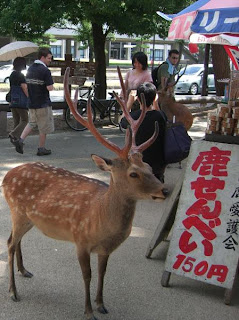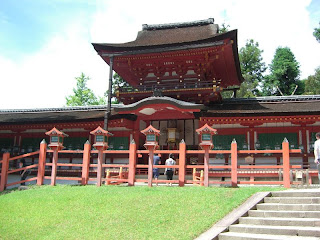We reached Nara around 10am and went looking for breakfast.. After having some onigiris, we walked to our first destination, Kohfukuji Temple (興福寺). The sun was merciless on this July morning.. even with sunblock, we can still feel the heat..
 Along the way, we passed by lots of deers, just resting by the stalls selling "senbei" (せんべい), which are some biscuit-like snacks for the tourists to feed these deers.. Seemed like there are always some deers "attached/allocated" to each stall.. They will come up to anyone who bought those "senpei" immediately and try to eat it.. More often than not, tourists, especially ladies or children, get frightened and just threw all the "senpei" at the deers in hope that they stopped "chasing"..
Along the way, we passed by lots of deers, just resting by the stalls selling "senbei" (せんべい), which are some biscuit-like snacks for the tourists to feed these deers.. Seemed like there are always some deers "attached/allocated" to each stall.. They will come up to anyone who bought those "senpei" immediately and try to eat it.. More often than not, tourists, especially ladies or children, get frightened and just threw all the "senpei" at the deers in hope that they stopped "chasing".. For me, I decided not to buy any to feed these deers, as it is not natural... Deers should eat grass. Period. :P
 We first came to Tokondo (東金堂), one of the three "golden halls" of Kohfukuji Temple. We also saw the ever-present Five-storied Pagoda (五重塔) not far from it..
We first came to Tokondo (東金堂), one of the three "golden halls" of Kohfukuji Temple. We also saw the ever-present Five-storied Pagoda (五重塔) not far from it.. Seemed to me that almost every "old" temple had something to boast about their pagodas.. This one is the 2nd highest pagoda in Japan, restored in 1426 and it gazetted as a National Treasure.
Entrance fee to enter Tokondo (東金堂) is 600yen per person. The two main Bosatsu (菩薩) placed here are Yakushi Nyorai (薬師如来) and Monju Bosatsu (文殊菩薩). There are other statues in this Hall too, some of them are Registered National Treasure, while some are Important Cultural Property. As usual, no photography is allowed inside these places..
To enter to the Kohfukuji National Treasure House (興福寺国宝館), one has to pay 500yen per person.. Lots of wooden sculptures and Buddhist cultural artifacts made in the Heian Era (平安時代: 794–1185AD) and Kamakura Era (鎌倉時代: 1185–1333AD) are on display. Again, many of them are Registered National Treasure and Important Cultural Property..

In the vicinity is Kohfukuji Nan-Endo (興福寺南円堂), another World Heritage Site as shown in the photo above.
After Kohfukuji Temple, we made our way to Todaiji Temple, where the world biggest bronze statue of Buddha (Daibutsu,大仏) is housed. Entrance fee is 500yen per person.

Different from other temples, cameras are allowed into the Todaiji Temple, however, as a form of respect, I tried not to use flash when taking photos of these statues. Thus the resultant photos weren't very sharp.. :(


Other than the big statue of Buddha, there are several smaller statues of various Bosatsu (菩薩) and divine beings.. Among them are Kokuuzo bosatsu (虚空蔵菩薩) at the right of the Big Buddha, Nyoirin-kannon (如意輪観音) of the left with Koumoku-ten (廣目天) and Tamon-ten (多聞天) sitting slightly behind them.. There is also a pillar which was said that if one can squeeze through the hole at the bottom, one's wishes will be granted. When we were there, a middle-aged Korean lady was trying to squeeze that small hole through amidst the cheering crowd around.. Not sure if she succeeded or not..
Then we went to Todaiji Hokke-Do (東大寺法華堂) also known as Sangatsu-do (三月堂), yet another World Heritage Site. Paid 500yen per person to get a glimpse of a couple more Registered National Treasures (12 to be exact) and Important Cultural Properties.. The center piece, Fukukensaku-kannon-bosatsu (不空羂索観音菩薩) is very impressive.. It is surrounded by Gakko-bosatsu (月光菩薩), Nikko-bosatsu (日光菩薩), Kongo-rikishi (金剛力士), Four Divine Kings (四天王) and a few more..

We passed by Tamukeyama-Hachimangu Shrine (手向山八幡宮), picture above, took some pictures and proceed to Nigatsu-do (二月堂).
 It is built on pillars of wood, much like Kiyomizu-Tera in Kyoto, but in a much smaller scale. One can see very far out from Nigatsu-do and the view was very good on this clear and sunny day.. We left quickly when we saw a huge group of tourists approaching.. We could even hear the tour guide explaining the history and structure of Nigatsu-do almost 100 meters away.. :x
It is built on pillars of wood, much like Kiyomizu-Tera in Kyoto, but in a much smaller scale. One can see very far out from Nigatsu-do and the view was very good on this clear and sunny day.. We left quickly when we saw a huge group of tourists approaching.. We could even hear the tour guide explaining the history and structure of Nigatsu-do almost 100 meters away.. :xNext stop, another World Heritage Site: Kasuga Taisha Grand Shrine (春日大社), about 15 minutes' walk from Nigatsu-do..
 We walked past rows and rows of stone lanterns at the side of the path leading to the Shrine..
We walked past rows and rows of stone lanterns at the side of the path leading to the Shrine.. Seemed like there will be some lighting up festival in the near future as all of these stone lanterns are sealed up.. maybe during Obon this Aug..
Again, paid 600yen per person to get into the Shrine..


Next, we went "hunting" for the Shin Yakushiji (新薬師寺). The map we had wasn't very clear so we just had to navigate.. We managed to find it somehow.. :) Here, the main Buddha is Yakushi (薬師), the patron Buddha of Medicine. It is a National Treasure, as it was carved out of one block of Kaya(Torreya) wood in the 8th Century. There are 12 figures standing in a circle around the main Buddha, each representing the 12 Divine Generals which also signified the 12 zodiacs in the Japanese calendar. There are some influences of Grecian style to both the Temple and the figures. Quite interesting..
Last stop for the day was Gangoji Temple (元興寺), yes, another World Heritage Site in Nara.. :) Some of the more interesting fixtures there..


By the time we reached back to Osaka and checked in back to Residence in Umeda, it was almost 9pm..
More photos from Day Three in Nara..
p/s: Same photos available in my Facebook photo album.
No comments:
Post a Comment